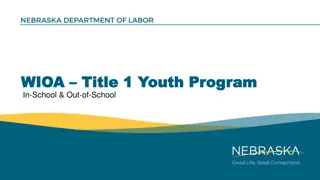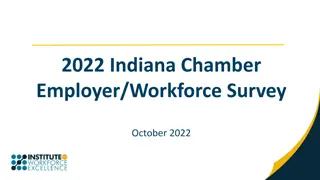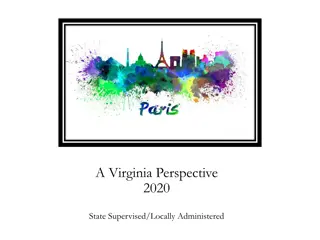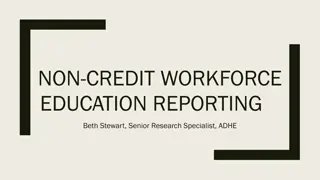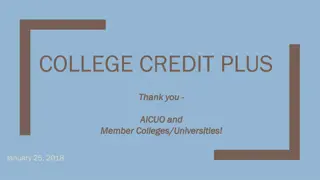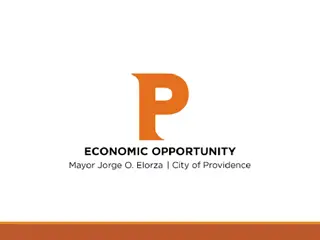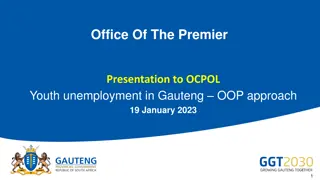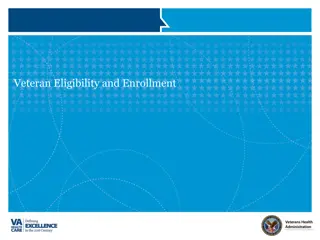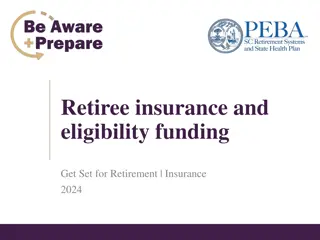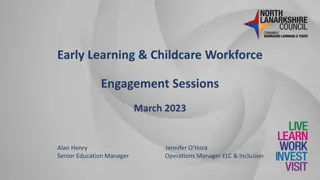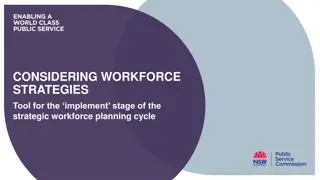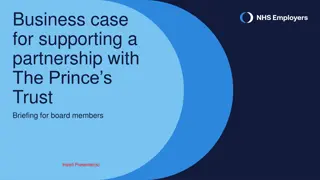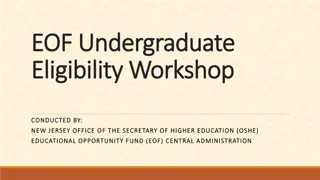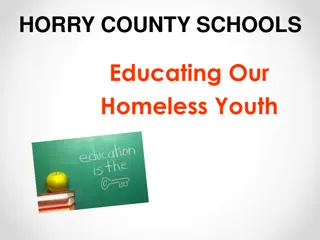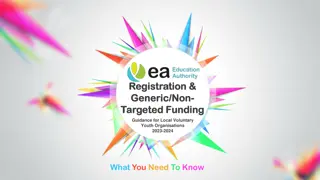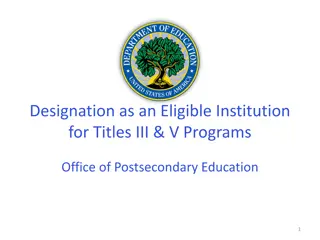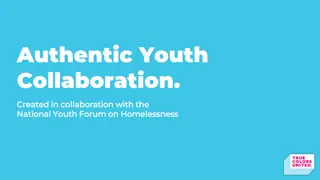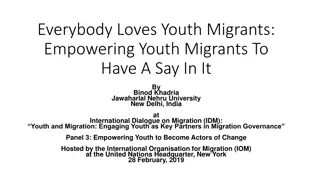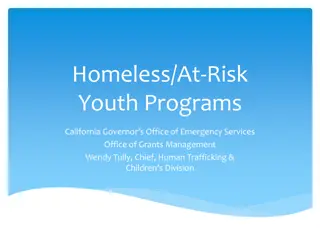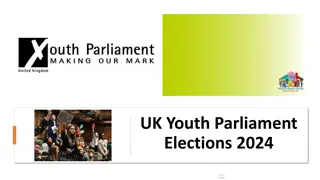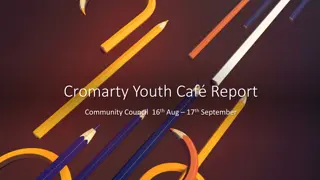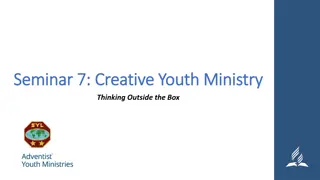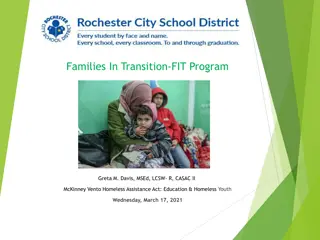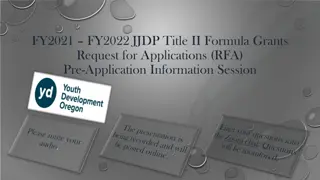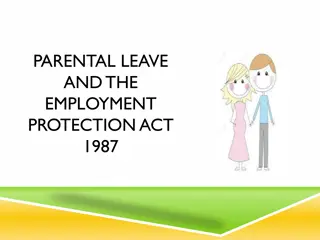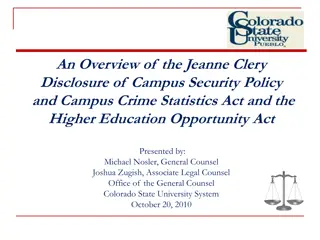Understanding Workforce Innovation and Opportunity Act Youth Eligibility
Explore the eligibility criteria and guidelines under the Workforce Innovation and Opportunity Act for youth programs, including general requirements, in-school versus out-of-school youth distinctions, and the importance of meeting selective service registration requirements. Learn about federal and state youth guidance, ePolicy manuals, and key considerations for WIOA applications.
Download Presentation

Please find below an Image/Link to download the presentation.
The content on the website is provided AS IS for your information and personal use only. It may not be sold, licensed, or shared on other websites without obtaining consent from the author. Download presentation by click this link. If you encounter any issues during the download, it is possible that the publisher has removed the file from their server.
E N D
Presentation Transcript
Workforce Innovation and Opportunity Act Youth Eligibility As of January 11th, 2020 1
Federal Youth Guidance Workforce Innovation and Opportunity Act of 2014 Training and Employment Guidance Letter 21-16 Third WIOA Title I Youth Formula Guidance dated March 2nd, 2017 2
Understanding the ePolicy Manual The Illinois Department of Commerce and Economic Opportunity, Office of Employment and Training (OET) utilizes a WIOA ePolicy portal where all current and new guidance issued by the Illinois Workforce Innovation Board (IWIB) and OET will be maintained. Homepage: www.illinoisworknet.com/DCEOPolicies 3
State Youth Guidance WIOA E-Policy Chapter 5 - General Eligibility WIOA E-Policy Chapter 5.1.1 1.1.4 Selective Service WIOA E-Policy Chapter 5.4 General Youth Eligibility WIOA E-Policy Chapter 5.4.1 Out-of-School Youth WIOA E-Policy Chapter 5.4.2 In-School Youth WIOA E-Policy Chapter 5.5 - Low-Income Individuals OET Notice NO. 19-NOT-03 - Basic Skills Deficient, Change 3 4
WIOA Youth Eligibility Prior to viewing this presentation on Youth Eligibility, it is important that you view and understand the details that were covered in the presentation on: WIOA General Eligibility 1-7-2021 WIOA Low Income 1-7-2021 WIOA Basic Skills Deficient 1-11-2021 5
General WIOA Eligibility General Eligibility Requirements - all registered individuals must meet two general eligibility requirements: Be a citizen or noncitizen authorized to work in the US; and Meet Military Selective Service registration requirements (males only) 6
WIOA Youth Program Workforce Innovation and Opportunity Act of 2014: In-School Youth is a separate category from Out-of-School Youth and the eligibility between these two are significantly different. 7
School Status at Application The school status should be recorded based on what the client is doing at the time of their WIOA application, not what the client will be entering as part of their WIOA services. 8
Guidance from TEGL 21-16 For purposes of WIOA, providers of Adult Education under Title II of WIOA, YouthBuild programs, the Job Corps program, high school equivalency programs, and dropout re-engagement programs are not considered to be schools for the purposes of determining school status, with one exception: Youth attending high school equivalency (HSE) programs, including those considered to be dropout re-engagement programs, funded by the public K 12 school system that are classified by the school system as still enrolled in school are considered ISY. 9
Determining School Status In Illinois Workforce Development System (IWDS), on the Education Status screen within the application, is where the question to determine if an individual is an In-School Youth (ISY) or an Out-of-school Youth (OSY). The Attending School question has the internal logic criteria and determines if a client will be considered an In School Youth (ISY) or an Out-of-School Youth (OSY) within IWDS. 10
Determining ISY Status If the question of Attending School is populated with a Yes , the internal logic will determine the client as an ISY. 11
Determining OSY Status If the question of Attending School is populated with a No , the internal IWDS logic will determine the client as an OSY. 12
Excluding Adult Education To reiterate, for the Attending School question in IWDS, if the individual applying for the WIOA Youth program is currently part of an Adult Education under Title II of WIOA, OR YouthBuild programs, OR the Job Corps program, the question of attending school should be recorded as a No . 13
WIOA In-School Youth WIOA E-Policy Chapter 5.4.2 In-School Youth: In-School Youth Youth not younger than 14 or older than age 21 Attending school (as defined by state law) 14
In-School Youth WIOA E-Policy Chapter 5.4.2 In-School Youth: 95% of the In-School Youth must meet low-income criteria (see WIOA E-Policy Chapter 5.5 - Low-Income Individuals) As mentioned earlier, it is essential that you have viewed and understand the previous power point on WIOA Low Income, so you understand the eight different ways an In-School Youth client could meet WIOA Low Income criteria. Lastly, all In-School Youth clients must have one or more of the following barriers shown on the next slide. 15
WIOA In-School Youth Barriers 1. 2. 3. 4. 5. 6. 7. 8. 9. Basic Skills Deficient An English Language Learner An offender Homeless Runaway Foster Child or aged out of foster care Pregnant or Parenting An individual with a disability An individual requiring additional assistance to enter or complete an educational program or to secure or hold employment. 16
Basic Skills Deficient Basic Skills Deficient respect to an individual (A) who is a youth, that the individual has English reading, writing, or computing skills at or below the 8th grade level on a generally accepted standardized test; or (B) who is a youth or adult, that the individual is unable to compute or solve problems, or read, write, or speak English, at a level necessary to function on the job, in the individual s family, or in society. 17
Basic Skills Deficient As was covered in the separate presentation on Basic Skills Deficient (BSD), there are three different ways an individual could meet BSD criteria: 1. Scoring at or below 8th Grade Level Equivalency (GLE) on their pre-assessment math or reading tests. 2. Being determined BSD due to the Basic Skills Screening Tool. 3. If a Youth Client is assessed as an English Language Learner (ELL) they are also considered BSD. 18
Basic Skills Deficient (BSD) A key internal logic item in IWDS to understand about BSD from assessment tests: The assessment test date must be, on or before the application date before the internal logic within IWDS is going to pick up the client as BSD due to the assessment test: Example, if a client has an application date of 1/4/2021, but was given the assessment test(s) on a date after 1/4/2021, even if the client scores at or below 8th Grade Level on the assessment test(s), the internal IWDS logic would not determine the individual BSD based on the assessment test. 19
Basic Skills Screening Tool If an individual replies No to any of the following questions on the screening tool, they can be determined BSD: 20
Basic Skills Screening Tool Within IWDS, on the Education Status screen within the application, is where the question has been added when a client is being determined BSD due to the new screening tool. If any question on the screening tool is answered No by the client, then the question related to the BSD screening tool on the Education Status screen should be answered Yes ; (see example on next slide). 21
Basic Skills Screening Tool Demonstrating recording BSD due to the screening tool. 22
English Language Learner English Language Learner the term English language learner when used with respect to an eligible individual, means an eligible individual who has limited ability in reading, writing, speaking, or comprehending the English language, and (A) whose native language is a language other than English; or (B) who lives in a family or community environment where a language other than English is the dominant language. 23
Youth Barriers Within IWDS, on the Characteristics and Barriers screen within the application, is where the question has been added when a client is being determined an English Language Learner (ELL). If the question is populated with a Yes , the client must pass on a Language of Preference; (see example on next slide). 24
English Language Learner Demonstrating barrier of ELL being recorded. 25
Youth Offender Barrier Offender - An adult or youth (A) who is or has been subject to any stage of the criminal justice process, for whom services under this Act may be beneficial; or (B) who requires assistance in overcoming artificial barriers to employment resulting from a record of arrest or conviction. 26
Youth Offender Barrier Within IWDS, on the Characteristics and Barriers screen within the application, if either of the two questions highlighted in blue below are answered with Yes , it would meet the criteria for ISY barrier of Offender . 27
Youth Homeless Barrier 1. Individual who lacks a fixed, regular or adequate nighttime residence; as defined in the Violence Against Women Act of 1994, or 2. Adult or youth with a primary nighttime residence that is a public or privately operated shelter for temporary accommodation as defined in the McKinney-Vento Homeless Assistance Act 28
Youth Barrier of Homeless Within IWDS, on the Characteristics and Barriers screen within the application, if the question of Homeless is answered with Yes , it would meet the criteria for the Youth barrier of Homeless . 29
Foster Child Within IWDS, on the Characteristics and Barriers screen within the application, if the question of Foster Child is answered with Yes , it would meet the criteria for the Youth barrier of Foster Child . 30
Aged out of Foster Care Within IWDS, on the Characteristics and Barriers screen within the application, if the question of Youth Aged Out of Foster Care is answered with Yes , it would meet the criteria for the Youth barrier of Youth Aged Out of Foster Care . 31
Runaway Within IWDS, on the Youth Barriers screen within the application, if the question of Runaway Youth is answered with Yes , it would meet the criteria for the Youth barrier of Runaway . 32
Pregnant or Parenting Barrier Within IWDS, on the Youth Barriers screen within the application, if the question of Pregnant/Parenting Youth is answered with Yes , it would meet the criteria for the Youth barrier of Pregnant or Parenting Youth . 33
An Individual with a Disability Within IWDS, on the Private Information screen within the application, if the question of individual with a disability has any response other than No or Prefer Not to Answer , the Youth Barrier of Individual with a Disability will be identified. 34
Youth Barrier Must Understand Under Youth eligibility, there is a barrier for, An individual requiring additional assistance to enter or complete an educational program or to secure or hold employment. It is important to understand the criteria to support this barrier is determined by each Local Workforce Innovation Area (LWIA) in their own Local Policy. If this barrier is indicated in an application, staff must explain in the case note (or with appropriate documentation), how the client meets the criteria that is laid out within the LWIA Policy on this barrier. 35
Youth Requiring Assistance Within IWDS, on the Youth Barriers screen within the application, if the question of Youth Needing Assistance is answered with Yes , it would meet the criteria for the Youth barrier of Youth Requires Additional Assistance . 36
Concludes In-School Youth (ISY) This concludes the portion of the presentation on ISY, key points to remember are for an ISY the Youth is required to meet WIOA Low Income criteria and have one or more of the identified Youth barriers. 37
Out-of-School Youth Eligibility WIOA E-Policy Chapter 5.4.1 Out-of-School Youth Out-of-School Youth Youth not younger than 16 or older than age 24. 38
Out-of-School Youth WIOA E-Policy Chapter 5.4.1 Out-of-School Youth Not attending any school as defined under state law. Individuals attending Adult Education provided under Title II of WIOA, YouthBuild or Job Corps are also classified as out-of-school youth for eligibility determination; 39
Guidance from TEGL 21-16 If a youth graduates high school and registers for postsecondary education but does not ultimately follow through with attending postsecondary education, then such a youth would be considered an OSY if the eligibility determination is made after the point that the youth decided not to attend postsecondary education. If the youth is only enrolled in non-credit-bearing postsecondary classes, they would not be considered attending postsecondary school and, therefore, an OSY. 40
The following out-of-school youth barriers do not require the individual to meet low-income criteria: 1. School Dropout 2. Within the age of compulsory attendance but has not attended school for at least the most recent complete school year quarter 3. Subject to the juvenile or adult justice system 4. Homeless 5. Runaway 6. Foster care or aged out of foster care 7. Pregnant or parenting 8. An individual with a disability 41
High School Drop Out This barrier can only be used for an individual who drops out of High School and has not gone back to school. If they dropped out but went back or obtained their General Equivalency Degree (GED), they are not considered a Drop Out under WIOA Eligibility. Within IWDS, on the Education Status screen within the application, if the question of High School Dropout is answered with Yes , it would meet the criteria for the OSY barrier of High School Dropout (see next slide). 42
Documenting High School Drop Out On Education Status screen of application is where OSY barrier of High School Dropout is recorded. 43
Not Attended High School in a Quarter In some instances, a High Schools might not consider an individual to be a High School Drop Out until the end of a school year. Under the WIOA legislation, the Out-of-School Youth barrier of Within the age of compulsory attendance but has not attended school for at least the most recent complete school year quarter was added for this reason. 44
Not Attended High School in a Quarter Within IWDS, on the Youth Barriers screen within the application, if the question of Within age of Compulsory School Attendance, but not attending School? is populated with a Yes , the OSY barrier of Within the age of compulsory attendance but has not attended school for at least the most recent complete school year quarter will be met. 45
Subject to Justice System Under the WIOA legislation, under In-School Youth (ISY) there is a barrier for an Offender , for the Out-of- School Youth (OSY) this barrier is called, Subject to the juvenile or adult justice system. In the March 2017, TEGL 21-16 WIOA Youth guidance it was clarified that the OSY barrier of Subject to the juvenile or adult justice system has the same definition as the ISY barrier of Offender . 46
Subject to Justice System An adult or youth is Subject to the Juvenile or Adult Justice System if, (A) who is or has been subject to any stage of the criminal justice process, for whom services under this Act may be beneficial; or (B) who requires assistance in overcoming artificial barriers to employment resulting from a record of arrest or conviction. 47
Subject to Justice System Within IWDS, on the Youth Barriers screen within the application, if the question of Subject to Juvenile or Adult Justice System is populated with a Yes , the OSY barrier of Subject to Juvenile or Adult Justice System will be met. 48
Out-of-School Youth Barriers For the other Out-of-School Youth barriers that do not require a client to meet WIOA low-income criteria are shown in the adjacent column, we have already covered the place in the application where those questions are addressed to record those barriers. Homeless Runaway Foster care or aged out of foster care Pregnant or parenting An individual with a disability 49
Out-of-School Youth Barriers If an Out-of-School Youth (OSY) did not meet any of the previously addressed barriers, there are two more possible barriers that could support OSY eligibility, but both require the client to meet WIOA Low Income criteria with the barrier. 50


